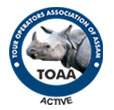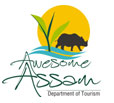
Natural Holidays
Travel Agent
H. No- 40, Rajgarh Road, Near Icon Academy,
Guwahati-3, India
Travel Desk : +91-9435378775
Mobile No : +91-9864511081, +91-9435018775
office@naturalholidays.in, naturalholidaysindia@gmail.com
Guwahati, Nameri, Jorhat, Majuli, Kaziranga, Guwahati
(7N/8D) - CODE ( 9 )
Day - 1 : Guwahati to Nameri - 245 kms; Drive time: 5.5 hours
Pickup from Guwahati Airport / Railway Station and drive to Nameri .O/n at Nameri or Bhalukpung.
Situated in the foothills of the Eastern Himalayas Nameri Tiger Reserve is one of the most scenic parks in all of India. This 200 sq. km park lies on the border of Assam and West Arunachal with the altitude varying between 80m and 300m. Most parts of Nameri are covered by Moist Mixed, Deciduous Forests and over 600 species of plants can be found in the area. It is the only place in India where one can see the highly endangered, White-winged Wood Duck, a resident of the dense tropical evergreen forest. is home to many other bird species like Sultan Tit, Ruby-cheeked Sunbird, Pin-tailed Green Pigeon, Common Merganser, Ibis Bill, Silver-breasted Broadbill, Oriental Hobby, Crow-billed Drongo, Maroon Oriole and many more wonderful birds. If lucky, one can see large congregations of Whreath & Great Pied Hornbills..
Day - 2 : Nameri
In the morning you can raft on the Jia Bhorali river for observing water birds like Ibis Bill, Blyth's Kingfisher, White-capped River-chat and the rare Long-billed Plover. In the afternoon go for a forest trek on the other side of the river . O/n at Nameri / Bhalukpung.
Day - 3 : Nameri to Jorhat - 180 kms; Drive time: 5 hours
In the morning you can go for a trek on another route in the forest. By mid day you will need to leave for Jorhat. O/n at Jorhat
Day - 4 : Jorhat to Majuli
Leave early in the morning to visit the Hollogapara sanctuary which is home to 6 species of primates namely Hoolock Gibbon, Pig tailed macaque, Stump tailed macaque, Assamese macaque, Rhesus macaque and Slow Loris. Leave from the sanctuary by 12 pm and head to Nimati ghat from where you will take a ferry over the Brahmaputra to go to Majuli island. O/n in Majuli.
Day - 5 : Majuli
Majuli, one of the largest river island in the world is a storehouse of art and culture. The name is a conjunction of Ma which denotes Laxmi (the godess of prosperity) and Juli meaning granary. The island has been the hub of Neo-Vaishnavite culture since the 15th century, having been initiated by the revered Assamese saint Sankardeva. This new creed of faith started by Srimanta Sankardeva preached devotion to a single God, Lord Krishna or Vishnu, (Eka Sarana). The hallmark of the Neo-Vaishnavite movement is reflected in two distinctively unique institutions, viz., the Satra and the Namghar, both of which are intimately associated with the social, cultural as well as religious life of the Assamese society.
Besides culture, Majuli is also a hotspot for birders with many migratory birds favoring its wetland ecosystem. Many species like the Spot Billed Pelican, Greater and Lesser Adjutant Stork, Open Billed Stork, Purple Heron, Whistling Teal, Rudy Shell Duck can be seen in the plentiful.
Before breakfast you can do a boat ride in a country boat for seeing water birds like Open billle Stork and Pellicans. Post breakfast visit some of the Satras to get an understanding of the Vaishanvite culture. Stop over at the mask making and pottery villages, to interact with the artisans. If you like to cycle then you can also go out to explore the island on cycle. O/n in Majuli
Day - 6 : Majuli to Kaziranga - 85 kms; Drive time: 2 hours
After breakfast take a ferry back to Nimati Ghat, from where you will drive back to Kaziranga. O/n at Kaziranga.
Day - 7 : Kaziranga
Circumscribed by the mighty Brahmaputra towards the North and East, and by the Mora Diphlu in the South, Kaziranga National Park is home to the largest population of the One Horned Rhinoceros in the world, as well as one of the highest density of tigers in a protected reserve. Other herbivores like the Wild Asiatic Water Buffalo, Eastern Swamp Deer, Hog Deer and Wild Boars are seen here in abundance. The park has treasures to offer to the avid birdwatcher as well, with many rare species in view like Pallas's Fish Eagle, Spotbilled Pelican, Lesser Adjutant, Swamp Francolin, Blue-bearded Bee-Eater, and Finn's Weaver.
Rise up early in the morning for a safari on Elephant back which would get you really close to the Rhinos. After breakfast head out for a jeep safari in the Eastern Range (Agaratoli) of the park . The birds likey to be seen are Pallas Fish Eagle,Lesser Adjutant, Swamp Francolin, Spotbilled Pelican, Barheaded Goose, Grey headed Lapwing, Blacknecked Stork. After lunch go for a safari in the Western range of the park where concentration of Rhinos is very high, also you will mainly see grassland birds like Chestnut-capped Babbler, Blackfaced and Yellow Breasted Buntings over here. O/n at Kaziranga .
Day - 8 : Kaziranga to Guwahati - 240 kms; Drive time: 5 hours
Today go for a safari in the Central Range of the park . This range includes nesting of the globally threatened Pallas's Fish Eagle and a colony of Spot-billed Pelicans. Many other woodland birds would be observed over here.
After lunch drive to Guwahati airport. Tour Ends
Copy Right Natural Holidays

